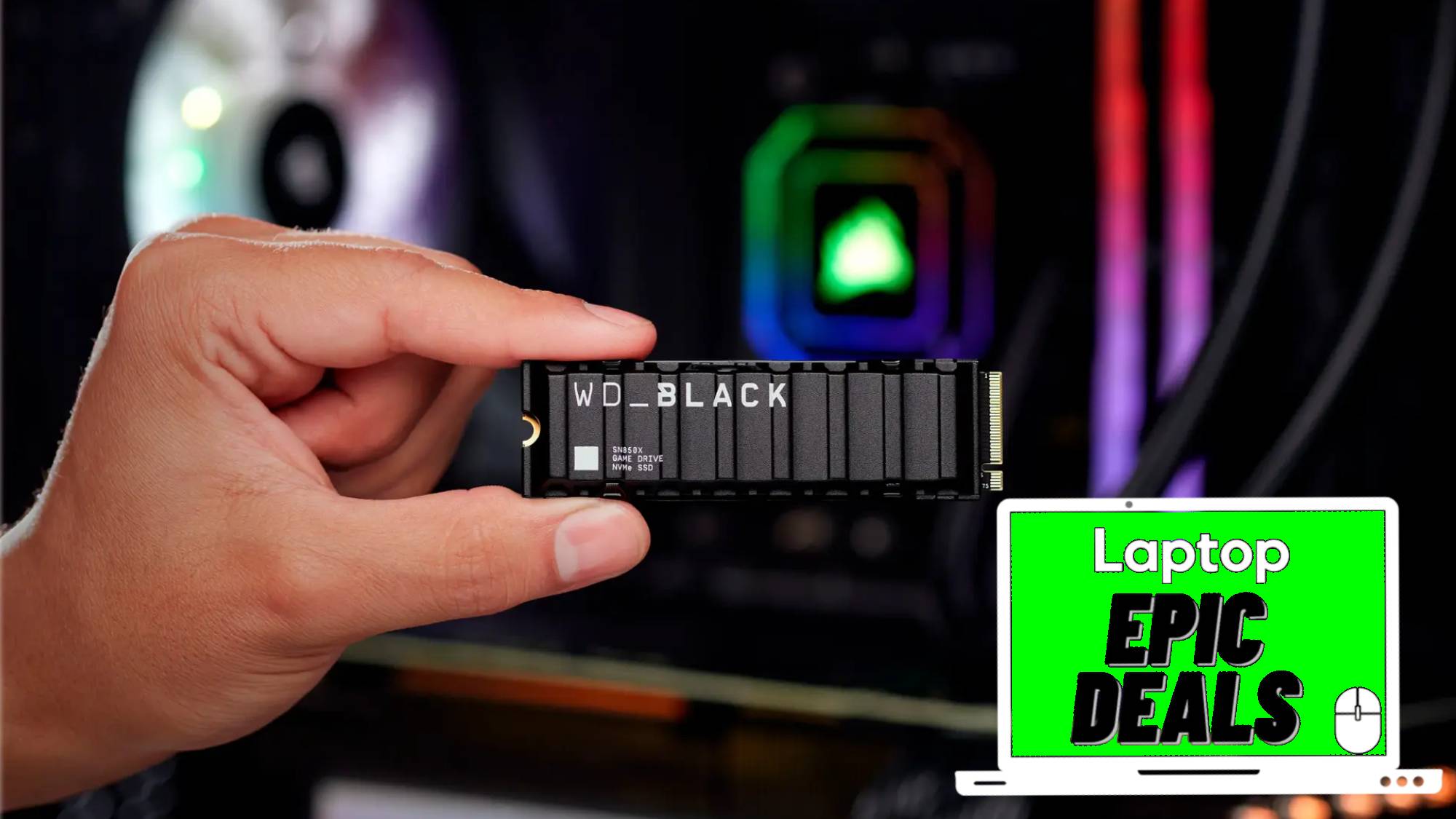Laptop Mag Verdict
The HP Pavilion 14 Chromebook brings Chrome OS to the big screen for a reasonable price, but the display could be brighter.
Pros
- +
Easy to use and family friendly
- +
Very good video quality and color
- +
Loud audio
- +
Aggressively priced
Cons
- -
Relatively dim screen
- -
Below-average battery life
- -
Doesn't support all Chrome apps
Why you can trust Laptop Mag
Most Chromebooks are small netbook-like affairs, with screens 12 inches and smaller, but the HP Pavilion Chromebook brings Google's Chrome OS to a larger 14-inch wide-screen display. This $329 notebook is designed to offer a better video- and photo-viewing experience compared to cheaper Chromebooks. But can a low-price Chromebook really be a great multimedia notebook?
Design
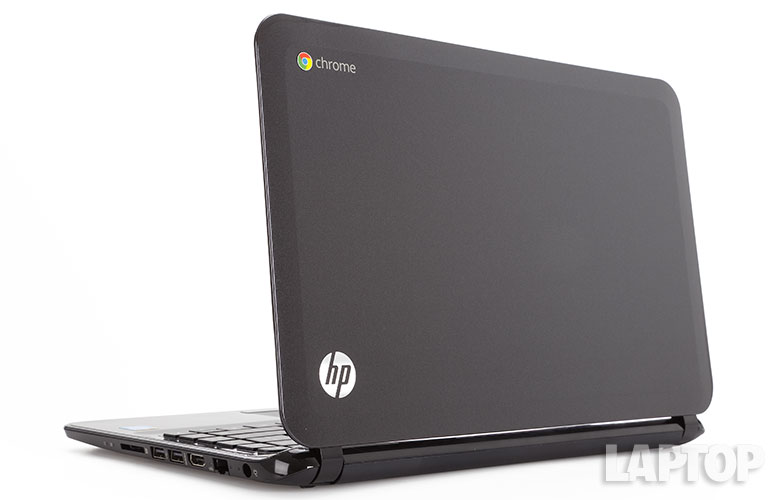
Click to EnlargeThe HP Pavilion 14 Chromebook is made of smooth black plastic, which sparkles ever so slightly when viewed in the correct lighting. A small Chrome logo rests on the top left corner of the lid with an HP logo in the bottom left corner. The bottom of the notebook is matte black with two small latches near the back edge, which lock the removable battery in place. The design might look familiar, as the body of the device is nearly identical to the HP Pavilion TouchSmart 15z-b000 Sleekbook.
The Pavilion 14 Chromebook measures 13.7 x 9.4 x 0.83 inches and weighs 3.8 pounds, which is larger and heavier than both the 11.2 x 8.0 x 1.1 and 3-pound Acer Chromebook C710 and the 11.5 x 8.5 x 0.8 inch and 3.2-pound Samsung Chromebook 5 550. But the HP Pavilion Chromebook also features a larger, 14-inch display, versus the C710's 11.6-inch screen and the 5 500's 12.1-inch display.
MORE: 20 Sexiest Laptops of All Time
We could easily pop the Pavilion into a bag and carry it around, but the size and weight was definitely apparent. Overall, the plastic aesthetic matches the fairly cheap price, but that's to be expected for under $350.
Keyboard and Clickpad
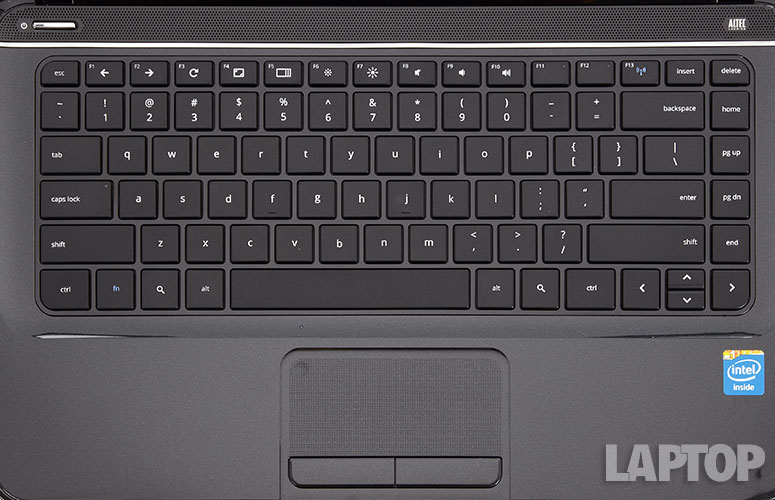
Click to EnlargeThey HP Pavilion 14 Chromebook has a spacious keyboard featuring full-size keys. We also like the Chrome-specific buttons in the Function row (such as Forward, Back, and Refresh), as well as keys for changing the screen brightness and volume. While there was little keyboard flex, we wished the keys offered slightly more travel and resistance. We were able to type 81 words per minute, approximately the same as our average, but we made a slightly higher number of mistakes.
We really like that the Pavilion 14 Chromebook has a touchpad with dedicated left and right buttons. The dotted textured touchpad measures 3.5 x 2.5 inches, which was plenty of room for navigating the desktop and performing gestures like two-finger scrolling and pinch-to-zoom.
Display
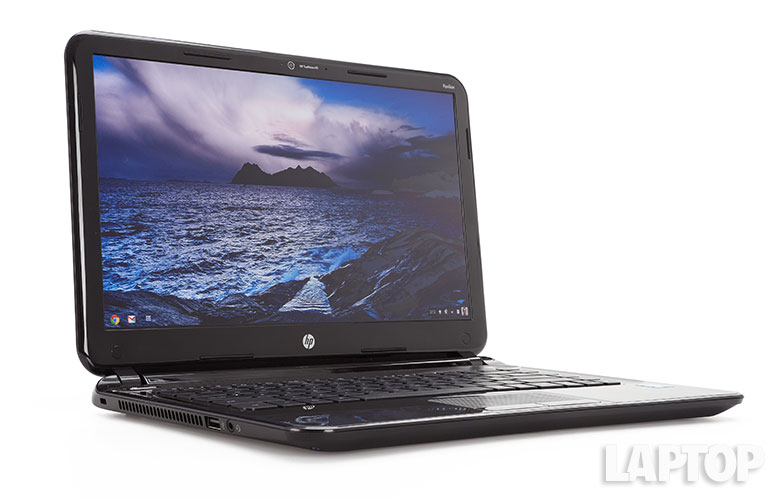
Click to EnlargeThe 14-inch 1366 x 768 HD BrightView LED-backlit display on the Pavilion 14 Chromebook produced vibrant colors and crisp images, much better than we expected from a notebook in this price range. Images were nice and clear as we watched the trailer for "Life of Pi," and colors were especially vivid in the bright and colorful scarves of the dancing women in India. Horizontal viewing angles were wide, but we had to dip the screen back a good 30 degrees to avoid wash-out.
Unfortunately, the screen just isn't that bright. The display measured 143 lux on our light meter, almost 100 lux lower than the 231 thin-and-light category average. Both the Acer C710 and the Samsung Chromebook Series 3 were brighter, measuring 202 lux and 176 lux, respectively.
Audio
The Pavilion 14's Altec Lansing dual speakers run across the top of the deck, right above the keyboard. We were impressed by the volume this Chromebook provided, which easily filled our small testing room. Audio quality was also high, with steady beats and a crisp, clear saxophone as we listened to Macklemore's "Thrift Shop." We then switched to Queen's "Don't Stop Me Now" and were equally impressed with the quality; the sound held up even on the high piano and vocal notes at high volumes.
Ports and Webcam
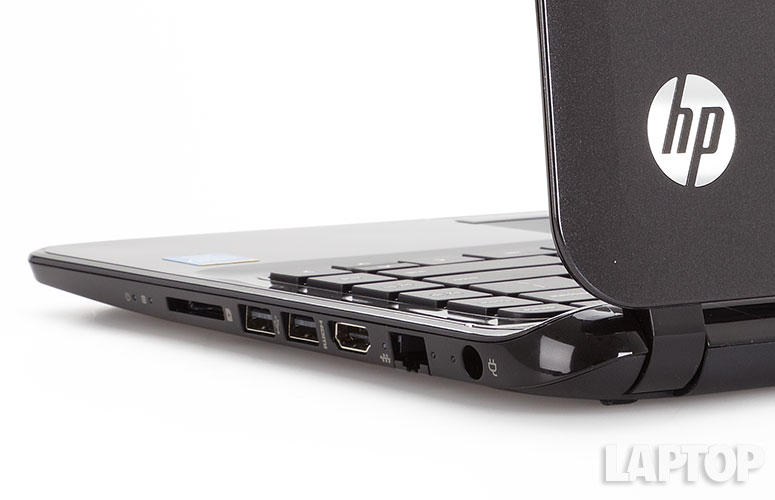
Click to EnlargeThe left side of the HP Pavilion Chromebook has a USB 2.0 port and a dual headphone and microphone jack. The right side has an SD and MMC 2-in-1 memory card slot, two more USB 2.0 ports, HDMI, Ethernet port and a power plug.
The HP Pavilion Chromebook features a 0.4 megapixel TrueVision HD Webcam. Colors were fairly accurate in captured images, but there was a little bit of visual noise and obscure lines. The camera also offered good low-light performance, although there was a slight bluish tint to the walls in the background of pictures we captured in a dimly lit room.
Heat
After streaming a Hulu video for 15 minutes, the Pavilion 14's touchpad measured 93 degrees Fahrenheit, the space between the G and H keys measured 87 degrees, and the middle of the underside was 94 degrees. That's close, but not above, our comfort threshold of 95 degrees.
Chrome OS
Click to EnlargeLike all Chromebooks, the HP Pavilion 14 runs Chrome OS, Google's desktop operating system, which is based on the Chrome Web browser as opposed to a traditional desktop experience.
Chrome OS gets constant updates, which are automatically rolled out to users via quick over-the-air installs. The Pavilion 14 runs version 27 of Chrome OS, which is much different than earlier versions of the operating system. There is now a desktop, which allows users to view websites or folders in windows, although neither files nor shortcuts can be saved to the desktop. There's also a basic file explorer, which organizes files saved to the hard drive as well as files in Google Drive.
Chrome OS offers support for multiple users, making this notebook a great device to share with an entire family. Users log into the notebook using their Google account and have instant access to all their saved bookmarks, browsing history and managed passwords. Alternately, users can also use this notebook in guest mode, which does not require a login and password. All guest sessions are treated similarly to a Chrome Incognito browsing session, so nothing is saved.
For more details, check out our Chrome OS review.
Apps
Click to EnlargeEvery Chromebook includes an entire suite of Google apps, which includes Chrome, Gmail, Google+, Calendar and YouTube. Additional apps can be downloaded from the Chrome Web store, which has tens of thousands of apps. These apps range from games, utilities and options that just act as a quick link to a website or service.
Most of the apps in the Web store require Internet connectivity, but there's an entire category of Chrome applications that can operate while the Pavilion 14 Chromebook is offline as well. Apps such as Gmail, Calendar and Drive can all be set up to work offline, increasing the productivity value of this notebook. Other apps, such as "Angry Birds," are also set up to work offline.
MORE: 20 Must-Have Apps for Your Chromebook
Click to EnlargeBut not all apps in the app store will work on the HP Pavilion 14 Chromebook. Chrome OS does not support Unity3D, a graphics-rendering engine used by many games, so these titles will not run on any Chromebook. We tried to play "Counter Strike CS Portable" without success, even though the same app worked fine in Chrome on our MacBook Air.
Remote Desktop
If you're feeling the restrictions of Chrome OS, or you just need to work on a file that's not on your Chromebook, you can use the Chrome remote desktop app, which lets you log in to another computer remotely by installing the Remote Desktop browser plugin for Chrome on that system. We were able to log onto a 13-inch MacBook Air in just a few minutes, and noticed very low latency.
Unfortunately, the remote desktop app isn't quite as robust as such remote-access apps as GoToMyPC and LogMeIn. We couldn't, for example, drag a file from the Air to the Chomebook, but we could copy text back and forth between devices.
Additionally, there's no way to adjust the aspect ratio between the two devices. When we logged into our Air, there were large black spaces on either side of the display. The screen couldn't be stretch or adjusted to fit the Pavilion's screen.
Cloud Print
Users can print from the HP Pavilion 14 Chromebook, but printing with Chrome OS is a little different than other operating systems. Chromebooks use the Google Service Cloudprint, which can network with cloud-ready printers, such as certain models from Canon, Epson, FedEx, HP and Kodak.
Chromebooks can also print from traditional printers, but not directly. Through Cloudprint, the Pavilion can network with another notebook that is connected to a traditional printer, and then select that printer as the destination.
Performance
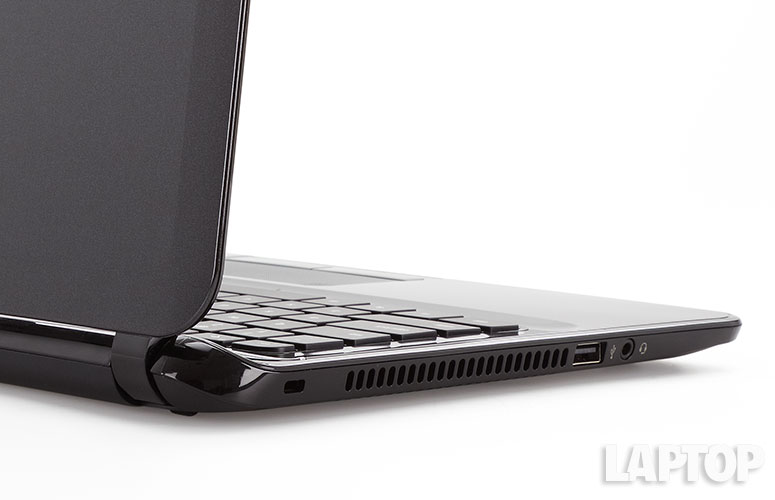
Click to EnlargeThe HP Pavilion 14 Chromebook has a 1.1-GHz dual-core Intel Celeron 847 processor with 2GB of RAM and an Intel HD Graphics GPU, which provides plenty of power to watch HD videos, browse the Web and play most Chrome OS games. Throughout our testing, we opened at least 10 different tabs, had the WebGL Aquarium open and were able to play "Plants Versus Zombies" without any problems.
LIke most other Chromebooks, the HP Pavilion offers a blazing fast boot time, loading Chrome OS in 8.6 seconds. The Acer C710 was slightly slower, loading in 14 seconds, and the Samsung Chromebook Series 3 booted in 11.3 seconds.
The Pavilion 14 scored 1,422 on the Peacekeeper benchmark test, which measures HTML5 performance. This is just under the 1,502 score of the Acer C710 (which has the same processor as the HP, but 4GB of RAM), but better than the Samsung Chromebook Series 3 (1.7-GHz Exynos 5 Dual processor and 2GB of RAM), which scored 1,214.
The Sunspider Javascript benchmark produced similar results, with the HP Pavilion 14 completing the test in 631.1ms, a touch slower than the 519.8ms of the Acer C710. The Samsung Chromebook Series 3 was even slower, taking 737.2ms.
Next, we opened the WebGL Aquarium with 50 fish and effects enabled, and the Pavilion 14 hovered at around 34 to 36 frames per second. Again, the Acer C710 outperformed the Pavilion by a hair, maintaining 40 to 42 fps. The Samsung Chromebook Series 3 was approximately the same, keeping between 37 to 40 fps in the aquarium.
The Pavilion 14 is designed for life in the cloud. With only 16GB of flash storage, this notebook won't be the best place to store your music and movie libraries, but Google does include 100GB of Drive storage for two years. The idea is that this cloud storage is an adequate replacement from internal storage, but we do wish this notebook had a little more of its own. Although the Samsung Chromebook Series 3 has the same 16GB of storage, the Acer Chromebook C710 has a much larger 320GB hard drive.
Battery Life
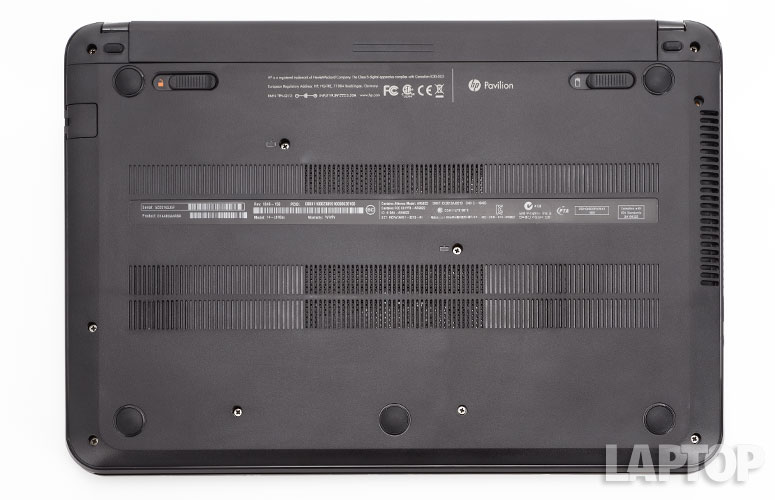
Click to EnlargeThe HP Pavilion 14 Chromebook performed better on the LAPTOP battery test (Web browsing over Wi-Fi with 40 percent screen brightness) than we were expecting. The 4-cell 2.55Ah lithium-ion battery in this notebook lasted a full 5 hours and 29 minutes, more than an hour longer than HP's claims. Unfortunately, this is still less than the 5:55 ultraportable average and behind the Acer C710 (6:32) and the Samsung Chromebook Series 3 (7:34).
MORE: 10 Laptops with the Longest Battery Life
Verdict
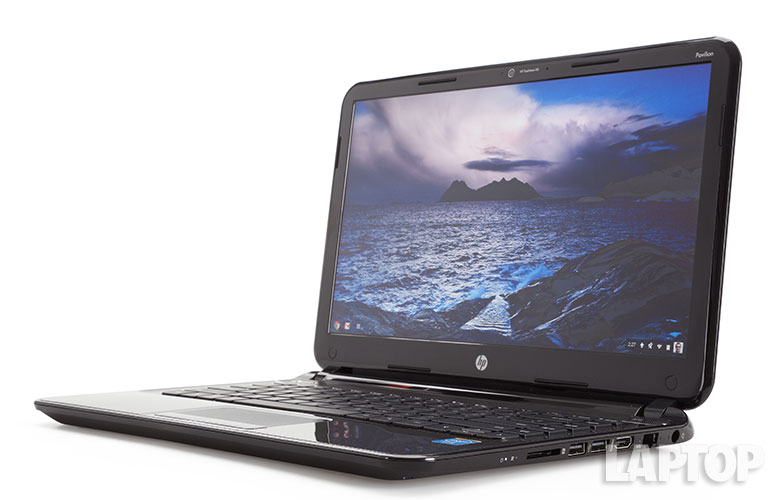
Click to EnlargeThe $329 HP Pavilion 14 Chromebook continues the trend of low-cost Chromebooks (with the exception of the pricey Chromebook Pixel) but offers a larger display than models by Acer or Samsung. The display and audio performance on the Pavilion were surprisingly good, even though we wished we could turn up the brightness a few more notches.
If you don't mind a smaller notebook -- and you're willing to live with Chrome OS's limited functionality -- we'd recommend the smaller but cheaper $249 Samsung Chromebook Series 3. You can also pick up a Windows 8 notebook with a Core i3 processor for just $50 more than this Chromebook. But if you like the idea of living in Chrome OS and want a larger screen, the HP Pavilion 14 Chromebook will do the trick.
HP Chromebook Pavilion Specs
| Bluetooth | Bluetooth 3.0 |
| Brand | HP |
| CPU | 1.1-GHz dual-core Intel Celeron 847 |
| Card Slots | 2-1 card reader |
| Company Website | http://www.hp.com |
| Display Size | 14 |
| Graphics Card | Intel HD Graphics |
| Hard Drive Size | 16GB |
| Hard Drive Speed | n/a |
| Hard Drive Type | Flash |
| Native Resolution | 1366x768 |
| Operating System | Google Chrome |
| Ports (excluding USB) | USB, HDMI, Ethernet, Combo Headphone/Mic Jack |
| RAM | 2GB |
| RAM Upgradable to | 4GB |
| Size | 13.66 x 9.37 x 0.83 inches |
| Touchpad Size | 3.5 x 2.5 inches |
| USB Ports | 3 |
| Weight | 3.8 pounds |
| Wi-Fi | 802.11a/b/g/n |
